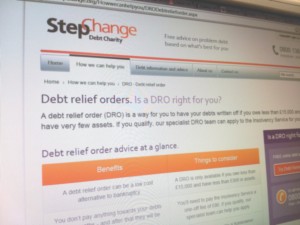Summer break for the kids – without breaking the bank
As a mum of two children, our guest blogger Emma knows all...
 Statistics reveal that the number of people applying for DROs is higher than bankruptcy. Even though they’re increasing in popularity they’re still not as well-known as their insolvency brothers, IVA and bankruptcy.
Statistics reveal that the number of people applying for DROs is higher than bankruptcy. Even though they’re increasing in popularity they’re still not as well-known as their insolvency brothers, IVA and bankruptcy.
DROs are often referred to as a form of “mini bankruptcy”, which isn’t too far from the truth. Like bankruptcy, it’s a way to get debts written off through the court system when you can’t afford to pay them back.
DROs are only available in England, Wales and Northern Ireland. Go to our debt advice in Scotland page to find out about debt solutions available if you live there.
If you meet the criteria then you’ll be placed into a 12 month ‘moratorium period’ (a fancy way of saying ‘waiting time’). During this year your debts will still exist but the courts will notify your creditors of the DRO, so you’ll not have to make payments to your creditors and they won’t be pestering you with letters and phone calls.
If your situation hasn’t improved by the end of the 12-month period you’ll be discharged from the DRO (a fancy way of saying that it’s ended) and your debts are written off.
To apply for a DRO you need to meet the following criteria:
We can help you work this out! If you contact us for advice we’ll plan a monthly income and expenditure budget which will show what you’ve got coming in and what you need to live off (not including debt payments or luxuries). By taking your outgoings away from your incomings we’ll know what’s left.
Basically as asset is something that you own that could be sold to raise money. It doesn’t include day-to-day things like clothes or furniture. It’s more things that are worth a bit, so if you’ve got a brand new 60-inch LED TV then you might not qualify for a DRO.
Credit cards, overdrafts, loans and any other kind of unsecured credit debts are included in a DRO – the kind of stuff folk most expect. However it’s often a surprise to people that arrears on household bills, benefit overpayments and items bought on finance are also included.
The fee for a DRO is £90 and is paid just before your application is submitted to the Insolvency Service. If you apply for your DRO through us we’ll send you a letter with a barcode on, which can be used to load up payments at local shops with PayZone facilities.
You can pay the £90 in instalments but will only be able to apply for your DRO once your payments add up to the total amount.
We can! We’re an ‘approved intermediary’ for DROs. We can put together an application with you and submit it to the Insolvency Service on your behalf.
Before doing any of this we’ll want to make sure a DRO is right for you, so we’ll look at your finances and advise you on all the options. So if you’re interested in a DRO get in touch with us. You can do this online using our advice tool Debt Remedy or by giving us a call.
If your finances change during a DRO notify the Insolvency Service and your situation will be reassessed. If you still meet the criteria your DRO will carry on; if you’ve had an improvement in your finances that means you don’t meet the criteria then your DRO will end and you’ll be back to paying your debts (but bear in mind that you should be better placed to deal with the debts).
Unfortunately yes, but if you’re already behind with your regular payments, it will be affected already anyway. It will be recorded on your credit file for six years, meaning it will be harder (but not impossible) to get credit during that time. After you’ve been discharged you can start working on gradually improving your credit score.
Responses